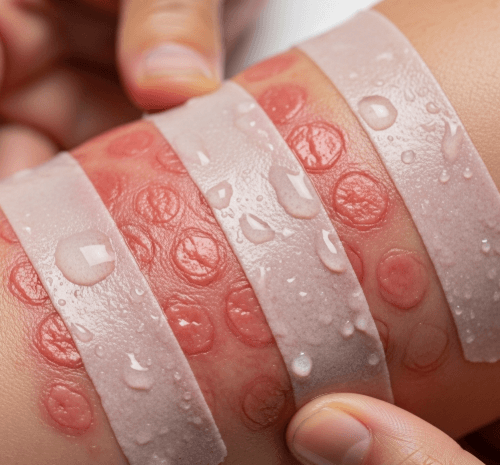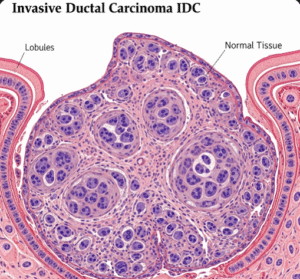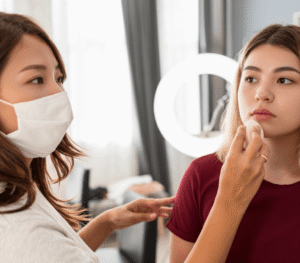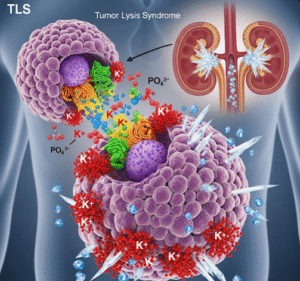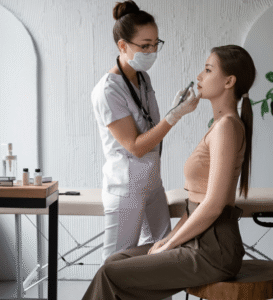What it is
➝ Nummular eczema (discoid eczema) is a chronic, relapsing inflammatory skin condition characterized by coin-shaped, itchy, oozing, or scaly patches on the skin.
➝ It commonly affects the arms, legs, and trunk, often in patients with dry skin or a history of atopic dermatitis.
➝ Wet-wrap therapy involves applying a topical medication (usually corticosteroid or emollient) to the affected skin, then covering it with a layer of damp bandages or clothing, followed by a dry outer layer.
➝ This technique increases skin hydration, enhances medication absorption, reduces inflammation and itch, and helps heal stubborn eczema lesions.
➝ In Korea, wet-wrap therapy is widely used in dermatology and pediatric clinics, especially for resistant or severe nummular eczema.
Why it’s done
→ To rapidly relieve itching, redness, and oozing in active nummular eczema.
→ To promote healing of chronic or lichenified plaques that do not respond well to creams alone.
→ To rehydrate severely dry and cracked skin, reducing risk of secondary infection.
→ To minimize the need for systemic corticosteroids by improving topical efficacy.
→ In Korea, wet-wraps are often recommended as an adjunct therapy during flares, especially in children.
Alternatives
→ Topical corticosteroids or calcineurin inhibitors alone.
→ Moisturizer therapy with intensive emollients and occlusive ointments.
→ Phototherapy (NB-UVB) for widespread eczema.
→ Systemic treatments (cyclosporine, methotrexate, dupilumab) in severe, refractory cases.
→ Lifestyle strategies: trigger avoidance (wool, harsh soaps, allergens) and consistent skin hydration.
Preparation
→ Cleanse skin gently with lukewarm water and mild, fragrance-free cleanser.
→ Apply prescribed topical corticosteroid or thick emollient (such as petrolatum or ceramide-rich cream) to affected areas.
→ Prepare two layers of wraps:
- Inner layer: damp cotton bandages or gauze, soaked in warm water and wrung out.
- Outer layer: dry bandage or clothing to cover the damp layer.
→ In Korea, dermatologists often provide pre-packaged wet-wrap kits and detailed instruction sheets for home use.
How it’s Done
→ Apply topical medication to eczema patches.
→ Cover treated areas with damp cotton bandages or clothing, then place a dry layer over it.
→ Leave wraps on for 2–4 hours, or overnight depending on severity and medical advice.
→ Repeat once or twice daily during flares, usually for up to 7–14 days.
→ After removal, apply a thick moisturizer to lock in hydration.
→ In Korea, wet-wrap therapy is often combined with humidifier use indoors to maintain optimal skin hydration.
Recovery
→ Patients usually notice rapid itch relief within 24–48 hours.
→ Eczema plaques improve visibly within 3–7 days, with less redness, oozing, and scaling.
→ Skin feels softer, calmer, and more hydrated, leading to better sleep and comfort.
→ Long-term remission is supported when wet-wraps are used during flares along with regular emollient maintenance.
Complications
→ Skin irritation or discomfort if wraps are too tight.
→ Infection risk if wraps are reused or not kept clean.
→ Corticosteroid overabsorption if used excessively under wraps, especially in children—hence medical supervision is essential.
→ Dryness rebound if emollients are not applied consistently after stopping wraps.
Treatment Options in Korea
→ Korean dermatologists often prescribe short courses of wet-wrap therapy for resistant nummular eczema patches.
→ Hospitals and clinics sometimes provide in-clinic wet-wrap sessions, followed by training for at-home care.
→ Topical corticosteroids or calcineurin inhibitors are commonly combined with wraps for maximum effect.
→ Korean skincare integration: patients are guided to use K-beauty emollients with ceramides, hyaluronic acid, and panthenol after wrap therapy.
→ Education is emphasized: families are taught how to apply wraps correctly, how long to use them, and how to maintain hygiene.
→ With Korea’s structured dermatology care, wet-wraps are considered a powerful rescue therapy, helping patients achieve faster relief and long-term eczema control with fewer systemic medications.

